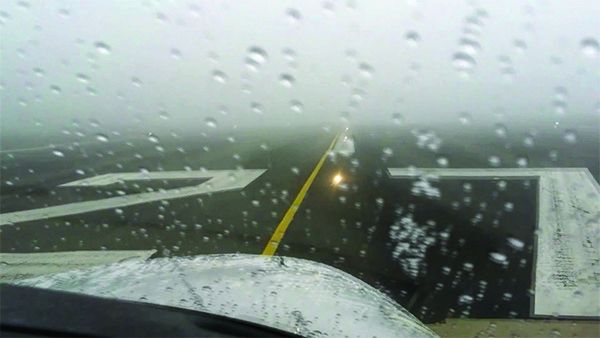
It was snowing hard in Elko, Nevada, and getting dark, too. The temperature was about freezing, of course. The FBO put the airplane into a hangar, where the snow melted quickly, and some time with squeegees and towels and a large movable stair got the moisture off the airplane. Our policy is that a clean airplane is the best method of ground deicing, followed by “get into the air right away.” (If there is any doubt, we get deicing.)
Elko is surrounded by mountains. One of the airport’s features is a funky LDA/DME approach to Runway 24 that means flying between two peaks. There’s an RNAV approach but it has higher minimums, so the LDA gets used. We had no trouble getting in, spotting the plowed runway among the snowy hills a few miles out. But now…. Dark? Wet? Mountains? How can we depart safely?
That can be a very complicated question. The answer requires pulling together almost everything you have ever learned about airplanes, performance, IFR procedures, charts, weather, emergencies, airspace and plain-old common sense.
CONSEQUENCES
Three fatal accidents remind us that this is serious business. In March 1991, a Hawker Siddeley HS.125 crashed soon after an 0142 local takeoff from Brown Field, near San Diego, California, killing 10 people. This was national news because the passengers were singer Reba McEntire’s band.
According to the NTSB report, the pilot told the local Flight Service Station that he did not have the departure procedure for the airport, so the specialist read it to him over the phone. But the pilot was also worried about the San Diego Terminal Control Area (what we now call Class B airspace). The plan was to depart VFR and pick up the clearance in the air. They departed toward high terrain in the middle of the night.
Several factors comprised this chain of events. Their IFR clearance had dropped out of the system, so there was an airborne delay while ATC put the flight plan back into the computer. Without a clearance, they stayed low. The second-in-command was legally qualified but had virtually no experience in the airplane, so probably wasn’t much help. And they were probably tired.
In August 1996, a USAF C-130 Hercules crashed into a mountain above 10,000 feet msl after a night takeoff from Jackson Hole, Wyoming, killing nine people. This made national news because the airplane was part of a Presidential support team.
Jackson Hole is in a steep, narrow valley with tall mountains within 10 nm on both sides. Despite this, the crew evidently ignored the published departure procedure; there was no discussion on the cockpit voice recorder. They turned east soon after takeoff, directly toward steep terrain. By contrast, the most current obstacle departure procedure (ODP) for the runway used calls for a straight-out climb for 27 nm.
And there’s a good reason for using published IFR procedures for VFR, especially night VFR. In November 2011, a Rockwell Commander 690 crashed into Superstition Mountain near Mesa, Arizona, killing six. This was a VFR night flight, and the pilot was evidently trying to stay below the Phoenix Class B tier while headed toward rising terrain. The current ODP for the departure airport starts everyone to the southwest, probably because of the high terrain to the east.
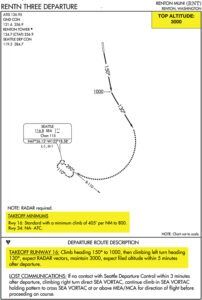
TWO KINDS OF DP
While most instrument-rated pilots learned about standard instrument departures (SIDs) in ground school, everyone needs to review Aeronautical Information Manual (AIM) Para. 5-2-9, Instrument Departure Procedures. It begins with, in part, “Instrument departure procedures are preplanned instrument flight rule (IFR) procedures which provide obstruction clearance from the terminal area to the appropriate en route structure.” It goes on to say, “There are two ypes of DPs, Obstacle Departure Procedures (ODP), printed either textually or graphically, and Standard Instrument Departures (SID), always printed graphically.” Aside from how they’re described, there’s a big difference between the two.
SID
There are two main reasons for developing a SID. First and most important is obstacle avoidance. But SIDs are also designed for ATC’s convenience. That sometimes means it’s also convenient for the pilots but also means it sometimes isn’t. A SID makes clearance delivery easier, turning a complicated route into just a few words. The SID also has altitudes and frequencies. Really, all that’s missing is the squawk code.
To see the ATC side, consider the Rentn Three departure, above right, from Runway 16 at the Renton (Wash.) Municipal Airport (KRNT). The basic idea is to climb straight out to a safe altitude and then turn southeast. That keeps you away from Sea-Tac departures, just a few miles to the southwest. The heading may not get you going in the right direction, but it keeps you away from the high traffic corridor. (It also keeps you out of the Seattle Class B airspace, which may be a problem for some faster airplanes—see the sidebar on page 18.)
Some SIDs have takeoff minimums. While takeoff minimums are at pilot’s discretion for Part 91 operations in the U.S., those operating under FAR 121 or 135 have to use them (although some ops specs allow otherwise). Takeoff minimums are a warning that obstacles are probably part of the picture! For the Rentn Three, the most recent takeoff minimums require a minimum climb of 405 feet per nautical mile until 800 feet, which is a steeper climb than the standard 200 feet/nm. You can use the gradient-to-rate table in the back of the FAA’s Digital Terminal Procedures Supplement (or the printed version), or you can do a little math. For example, at 90 knots groundspeed, one mile takes 40 seconds, which means a climb rate of a little over 10 fps, or 600 fpm. Use groundspeed because the ground is where the obstacles are.
At high density altitude, there is a big difference between indicated climb airspeed and true climb airspeed, and you have to adjust accordingly. At higher elevations when the IAS is 90 knots, the TAS can be 100 knots or more, so the climb rate must be higher to meet the minimum requirement.
A SID has a “top altitude.” When the ATC clearance says, “Climb via the SID,” you climb to that altitude unless cleared higher. Of course, ATC can modify the top altitude by saying, “Climb via the SID except maintain” a new assigned altitude.
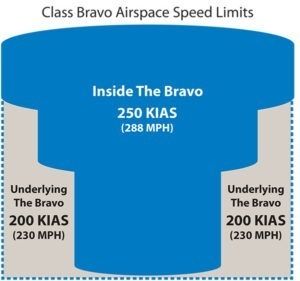
I flew for decades before having to worry about the 200-knot indicated airspeed restriction when flying under Class B airspace. The rule is in FAR 91.117(c): “No person may operate an aircraft in the airspace underlying a Class B airspace area…at an indicated airspeed of more than 200 knots (230 mph).”
Some fast airplanes might be tempted to accelerate to a higher speed on departure, but it’s not legal. I don’t fly anything that climbs at that speed, but my typical descent speed is 220-230 KIAS. Some Class B facilities allow that by leaving you inside the Class B, but some do not, especially if you are going to a satellite airport. It’s clear the ability to fly faster increases your need for airspace awareness.
Even without airspace issues, your turn radius increases with speed. When your groundspeed is high, you reach the high terrain quickly and then chew up more of your safety margin in the widened turn. That’s part of why the AIM recommends a 200-knot speed limit for procedure turns during instrument approaches (AIM 5-4-9).
WHEN THERE IS NO SID
Elko does not have a SID, so finding a safe departure takes a little more work. Look again at the FAA approach plates for Elko. Near the upper left is the PROCEDURE/PBN EQUIPMENT REQUIREMENTS box, sometimes just called the “Notes Box.” It’s not labeled: you’re supposed to know about it from studying the Digital Terminal Procedures Supplement or its paper equivalent. This box describes required equipment like radar or DME, notes like “Proc NA at night” or “Circling NA southeast of Rwy 3-21,” and other important bits of data that keep pilots safe and legal. Most of them are in (almost) plain English. But not all.
The Elko plates have two symbols, one a “T” in a downward-pointed black triangle, and the other an “A” in an upward-pointing black triangle. The “A” means that the field has non-standard requirements for filing as an alternate. The “T” means that there is an Obstacle Departure Procedure (ODP). Some pilots, for good reason, call it “The Trouble T.”
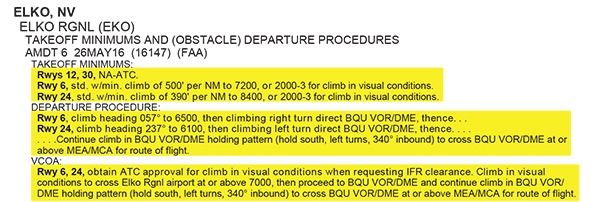
SO WHERE’S THE CHART?
The chart is harder to find than a SID chart. In fact, there may not even be a chart! Some ODPs are presented as text only. How you find the text varies from chart provider to chart provider and avionics manufacturer to avionics manufacturer. Some online sources list them with approach plates. ForeFlight lists “TAKEOFF MINIMUMS” under the DEPARTURES tab for the airport. The entry for Elko is reproduced in the box at below left.
These procedures get you from the departure end of a runway to Bullion VOR. After BQU, the procedures become the same, so only one description is needed. The holding entries are different, but we know how to do that, so they’re not written out. The hold may or may not be charted on one of the approach plates, so look at those. If not, draw a picture or use whatever approved entry technique you prefer to enter the hold.
And you will probably hold. Some procedures have radar coverage, but ATC can’t do anything but watch until you reach the minimum vectoring altitude. It might be tempting to turn on course when you hear “radar contact,” but don’t do it. Fly the procedure to the charted altitude.
One last “hack.” The procedures are hard to find, so take a screenshot of the description you can refer to more easily. That makes it a cinch to find when you need it again. And you will need it again.
ATC
Departure procedures are pilot’s choice unless explicitly included in the clearance, so in many cases you can make the smart decision to follow the procedure without telling anyone. But it’s always a good idea to tell ATC what you’re planning, and in one case it’s required. That’s the “visual climb over airport (VCOA)” procedure, which requires ATC approval. The VCOA option is in the text if it’s available.
The VCOA is a visual procedure, but it is still part of an IFR departure. Another option is to depart VFR and pick up your clearance in the air, but that means that you’ll be copying the clearance while your attention should be directed out the window. This might put you in the situation of the Hawker at Brown Field mentioned earlier. With VCOA, you already have the clearance and can program your avionics with the route before you take off.

My daughter works at the front desk at our FBO. As she left for work one bitter cold morning, I told her, “Tell the transients to watch for the snowflakes.” You can imagine her response.
Look at AIM para. 5-1-17, Cold Temperature Operations. Cold temperatures mean that the barometric altimeter reads higher than you really are: “High to low, look out below.” The AIM para. 7-2-3, Altimeter Errors, goes into the details. The error increases as you climb.
The “snowflake” on the approach plates means that you must apply the altimeter correction in AIM Table 7-3-1, below, to each segment of an approach when the surface temperature is below the charted temperature. You need to inform ATC that you are doing this. For example, the “snowflake” temperature at Aspen, Colorado (KASE) is -22 degrees C.
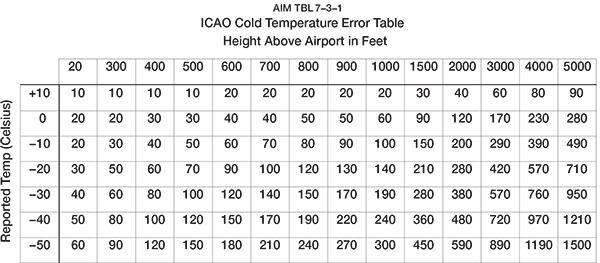
The AIM only discusses approaches, but you need to be aware of the error when you are departing, too. Many ODPs tell you to climb to a certain altitude before turning. If you don’t apply the correction, you will be too low when you turn, which is definitely a bad idea. It’s not a small error: When the temperature is -20 degrees C, the error is 140 feet when you are 1000 feet agl.
EMERGENCIES
Both kinds of departure procedures are based on climbing and, if you have an engine failure or other emergency you won’t be able to climb as well in a multi-engine airplane, or at all in a single. Commercial operators take this into account when checking whether they can meet the required minimum climb gradient. It’s not unusual to hear arguments between pilots (“we’re too heavy”) and passengers (“we have to get there on time”) in FBO lobbies at mountain airports.
Lighter airplanes climb better, and some POHs and AFMs have the data on maximum allowable weight based on temperature and pressure altitude. The lightest twin-engine airplanes aren’t even required to climb at all on one engine, so you have to plan like you’re in a single. That’s a personal choice: how much do you trust your engines?
THE FULL STORY
An article like this can only cover the basics of safe IFR departures. The FAA’s Instrument Procedures Handbook (FAA-H-8083-16B is the most current version) has all of the details on departures. Some common sense and patience will go a long way toward keeping you safe.
Jim Wolper is an airline transport pilot and mathematics professor. He’s also a CFI with single-engine, multi-engine, instrument and glider ratings.



